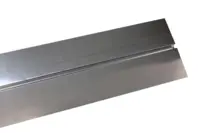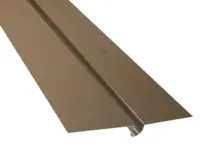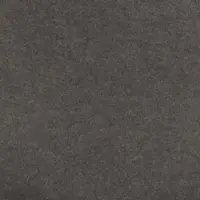- Forside
- Gode råd om gulv
- Vedligeholdelse
- Overfladebehandling af trægulve
- Akustikpaneler
- Afpassede tæpper
- Bambusgulve
- Bordplader & bordben
- Designgulve
- Fliser og klinker
- BeefEater gasgrill
- Gode råd om gulv
- Gulvtæpper
- Gulvvarme
- Græstæpper
- Korkgulve
- Køkken, bad & garderobe
- Laminatgulve
- Linoleumsgulve
- Maling, Væv & Spartel
- Måtter
- Møbler & Boliginteriør
- Nålefilt og messetæpper
- Plejeprodukter
- Restpartier & gode tilbud
- Sildebensparket & Stavparket
- Tæppefliser
- Terrassebrædder
- Tilbehør
- Trægulve
- Vareprøver
- Vinylgulv
- Værktøj
- Øvrige produkter
- Loft- og vægpaneler
- Flotte gulve
- Fyrretræsgulv
- Klikgulve
- Bestilte varer
-
-26%
-
Populær29,00 DKK
-
29,00 DKK pr m2
-
Populær21,00 DKK
-
-59%39,00 DKK pr m295,00 DKKDu sparer: 56,00 DKK pr m2
Overfladebehandling af trægulve
Alle informationer på denne side er kopieret materiale fra Gulvfakta som er et fagteknisk opslagsmateriale, Kilde: Gulvfakta
Såvel i forbindelse med renovering som i nybyggeri afslibes og overfladebehandles trægulve i stadig større omfang. Det er vigtigt, at dette arbejde bliver udført på en professionel måde.
5.3.0.1 Introduktion
5.3.0.2 Byggepladsforhold - forudsætninger
5.3.0.3 Arbejdsbeskrivelse for afslibning
5.3.0.4 Udfaldskrav for afslibning
5.3.0.5 Overfladebehandling
Alle informationer på denne side er kopieret materiale fra Gulvfakta som er et fagteknisk opslagsmateriale, Kilde: Gulvfakta
5.3.0.1 Introduktion
I denne sektion omtales:
• Krav til overtagelse inden afslibning påbegyndes.
• Anvisning på metode til afslibning af forskellige trægulvstyper og tilhørende udfaldskrav.
• Krav til overtagelse inden overfladebehandling påbegyndes.
• Anvisning på metoder til overfladebehandling af forskellige trægulvstyper samt tilhørende udfaldskrav.
Rengøring af trægulve omtales ikke her. Der henvises istedet til afsnittet Rengøring af trægulve
Trægulve har været brugt i den danske byggetradition i århundreder. Baggrunden for den mangeårige anvendelse er, at trægulve har et smukt udseende og stor slidstyrke og dermed lang levetid. Desuden er trægulve behagelige at opholde sig på. Der findes mange forskellige træarter, som i denne sektion er opdelt i bløde træarter, især nåletræ, og hårde træarter, især løvtræ og eksotiske træarter. Såvel i forbindelse med renovering som i nybyggeri afslibes og overfladebehandles trægulve i stadig større omfang. Det er vigtigt, at dette arbejde bliver udført på en professionel måde.
For at dette kan opnås, bør det i udbudsfasen beskrives nøjagtigt hvilke krav, der er til det færdige resultat, fx mht. planhed, overfladebehandlingens styrke og hvilket omfang af synlige knasthuller eller ar, der kan accepteres. Der udbydes mange forskellige materialer til overfladebehandling af trægulve. Ved valg af overfladebehandling er det vigtigt, at såvel brugsbetingelser som udseende overvejes nøje. Der skal udarbejdes rengørings- og vedligeholdelsesplaner med henblik på at sikre gulvets udseende og slidstyrke, se nærmere herom i sektionen om Rengøring. Ved projektering af afslibning/overfladebehandling bør der henvises til denne sektion på Gulvfaktas hjemmeside. Herved sikres det, at de bydende giver pris og udfører arbejdet efter de samme retningslinier og kvalitetsnormer. Gulvbranchen har ved udarbejdelsen af anvisningerne i denne sektion i vid udstrækning taget udgangspunkt i leverandørmedlemmernes erfaringer og praksis.
5.3.0.2 Byggepladsforhold - forudsætninger
Såfremt arbejdet foregår på andre etager end i stueplan, bør mekanisk transport være til rådighed til transport af gulvslibemaskinen. Affaldscontainer forudsættes at være til rådighed. Der forudsættes fri adgang til el - helst 380V/16 A - da gulvslibemaskiner er meget effektkrævende. I langt de fleste privathjem er der kun adgang til 230V/10 A. I boliginstallationer af nyere dato (diaset og neoset sikringer) kan der anvendes sikringer på 230V/13 A. Det er nødvendigt, at al anden unødvendig belastning er slået fra den gruppe, som skal trække gulvslibemaskinen. Afslibning af trægulve støver. Der skal derfor tages stilling til, om der skal ske afdækning ind til tilstødende lokaler og af objekter, som befinder sig i det eller de lokaler, hvor afslibning skal udføres.
Stueplanter og husdyr samt coated papir, fx telefax- og fotokopipapir, kan tage skade, og bør derfor fjernes inden overfladebehandling udføres.
Temperatur og fugtighed i luft og i træ
Inden arbejdet udføres, skal bygningen være lukket og tør, og der skal være sat varme på bygningen. Under hele udførelsen skal temperaturen være 17-25°C og luftfugtigheden 35-65% RF. Træets fugtindhold bør ligge mellem 7 og 12%. Under udførelse af overfladebehandling må der ikke forekomme træk.
Kvalitetskrav
For at opnå en tilfredsstillende kvalitet af afslibningsarbejdet og den efterfølgende overfladebehandling er det vigtigt, at det i udbudsmaterialet beskrives nøjagtigt, hvad der ønskes udført og hvilke udfaldskrav, der forventes af det færdige arbejde. Generelle byggeplads- og temperaturforhold etc. er beskrevet ovenover. I de efterfølgende afsnit er specifikke krav vedrørende gulvenes overtagelse og forventede udfaldskrav beskrevet. Endvidere er der i hver arbejdsbeskrivelse omkring overfladebehandlinger opstillet specifikke udfaldskrav.
Overtagelseskrav
Ved overtagelsen skal følgende krav være opfyldt:
Gulvet skal ligge fast og være stabilt, da der ellers kan komme uhensigtsmæssige mærker/ridser efter afslibningen. Eventuelt større skader skal være repareret ved udlusning. Søm eller skruer skal være dykket/forsænket min. 2 mm. (Det er nødvendigt at dykke/forsænke søm og skruer for at undgå at slibepapiret/valsen ødelægges, samt for at imødegå risikoen for afgivelse af gnister, som kan antænde slibestøvet i støvposen). Gulvoverfladen skal være fri for fedt, mørtelklatter, spartelmasse, lim, maling, silikone mv. Alle sandlister langs kantbegrænsninger (vægge) samt fejelister ved døre bør fjernes, så der kan slibes helt ud til kanterne.
OBS! Slidlaget i ældre lamelbrædder kan løsne sig ved afslibning og overfladebehandling. Årsagen kan være små vibrationer og varmeudvikling fra slibemaskinen. Ved lakering kan overfladespændinger i forbindelse med lakkens hærdning desuden føre til limsvigt mellem slidlaget og det underliggende lag.
Afslibning og efterfølgende overfladebehandling af trægulve bør udføres så sent i byggeprocessen som muligt for at undgå skader på gulvet fra andre håndværkere. Sidste gang maling af træværk skal dog vente til efter afslibning og evt. overfladebehandlinger af gulvet er tilendebragt, idet der kan forekomme småskader på tilstødende vægge og træværk. Såfremt der er gulvvarme, skal temperaturen sænkes til en normal rumtemperatur (20-21 °C). Gulvvarmeanlæggets temperatur må først hæves igen 5 døgn efter at overfladebehandlingen er udført. Temperaturen i gulvvarmesystemet må aldrig overstige den af trægulvsleverandøren fastsatte maksimumtemperatur.
Udfaldskrav - afslibning
Generelt skal gulvene, efter endt afslibning, overholde følgende:
• Gulvfladen skal være plan og jævn, og der må ikke kunne mærkes spring imellem de enkelte brædder/ stave. Overfladen skal være uden synlig "vaskebræteffekt".
• Gulvfladen skal være afslebet til rent træ.
• Der må ikke være "slibestop" eller "overgange" mellem slibning af fladen og langs kanter og i hjørner.
• Gulvet skal, vurderet i almindelig ståhøjde (1,6 m over gulvet), fremstå glatslebet, og der må ikke forekomme synlige ridser.
• Det anbefales, at knasthuller, større end 10 mm i diameter og/eller mere end 5 mm dybe samt søm- og skruehuller udkittes med egnet materiale.
Ved rent træ forstås, at overfladen efter afslibning er helt fri for den gamle overfladebehandling. For lakerede gulve betyder det, at der ikke må forekomme lakrester i træet.
Efter endt afslibning skal såvel gulvflader som tilstødende vandrette flader (fodpaneler, vindueskarme og lignende) støvsuges af hensyn til efterfølgende overfladebehandling. Træ er et naturprodukt, som ændrer farve ved lyspåvirkning. Der kan derfor forekomme farveforskelle efter endt slibning, hvis gulvet har været udsat for forskellig lyspåvirkning.
Udfaldskrav - overfladebehandling
Generelt skal gulvene, efter endt overfladebehandling, overholde følgende:
• Overfladen skal fremstå ensartet og glat og uden synlige overgange.
• Der må ikke være luftblærer eller væsentlige urenheder i overfladen.

Figur 1. Vaskebræteffekt kan genopstå i trægulve som ikke er beskyttet mod fugtpåvirkning nedefra.
Mindre støvpartikler i overfladen kan forekomme, fordi et støvfrit miljø ikke kan opnås. Små støvpartikler i overfladen slides hurtigt bort ved rengøring og brug af gulvet. Det anbefales at lave en slibe- og behandlingsprøve forud for arbejdets opstart til fastlæggelse af kvaliteten. En sådan slibe- og behandlingsprøve afregnes særskilt.
Maskiner
De oftest anvendte maskiner på markedet er bånd- og valseslibere til de store flader. Endvidere findes der høvlemaskiner til afretning af gamle gulve udført i bløde træarter.
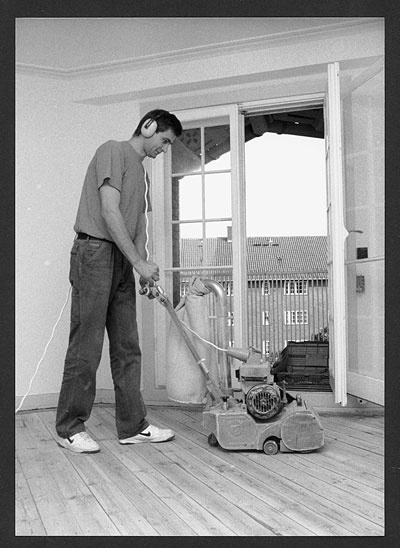
Til kanter eller svært tilgængelige steder bruges henholdsvis kant- og næbsliber. Til trapper bruges kantsliber i mindre model eller excentersliber.
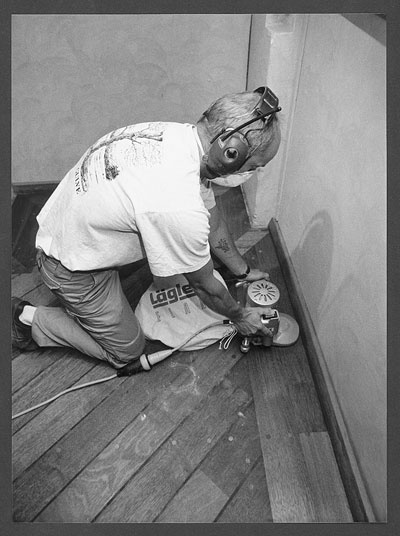
Endvidere bruges der rondel/polermaskine med slibenet og/eller forskellige polérpads.
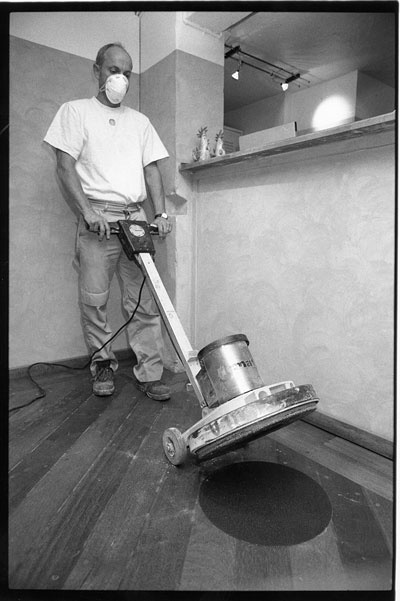
Fælles for alle maskiner er, at der bør være indbygget støvsuger med stofpose. Specielt for bånd- og valsesliberne er, at de altid skal være nøjagtigt indstillet, så trykket mod gulvet er ens, dvs. at valserne skal sidde fuldstændig lige. Valserne skal holdes rene for at opnå det bedste resultat, dvs. fri for støv og fastsiddende partikler, fx lakrester. Rensning af valser bør foregå med trykluft. Valserne bør kontrolleres jævnligt, og altid efter transport af maskinen.
Miljøkrav, herunder personlige beskyttelsesforanstaltninger
Ved afslibning kan det ikke undgås, at der spreder sig fint støv i luften. Desuden støjer slibemaskiner meget. Andre personer bør derfor ikke arbejde eller opholde sig i de områder, hvor afslibning finder sted. Den der foretager afslibningen skal sikre sig selv med de lovbefalede beskyttelsesforanstaltninger i form af åndedrætsværn med tilhørende filtre og høreværn. Det tilrådes at bruge en slibeolie med lav malkode. Leverandørens brugsanvisning skal følges. Emballagen til overfladebehandlingsprodukter, slibeolier m.m., skal være mærket efter gældende lovgivningskrav. Der skal være brugsanvisninger samt sikkerhedsdatablade til rådighed på arbejdsstedet. Af miljøhensyn bør alle produktrester afleveres til det lokale kemikaliedepot.
Brand- og sikkerhedskrav
Slibestøv er let antændeligt og brandfarligt, og slibestøvet skal derfor fjernes omgående. Produkter til overfladebehandling er ligeledes let antændelige, hvorfor brugte klude mv. skal overhældes med vand og lægges i plastposer. Såfremt kludene skal genanvendes på et senere tidspunkt, skal de opbevares i en dertil indrettet beholder af metal med tætsluttende låg. Der skal sørges for god udluftning, indtil overfladebehandlingen er tør.
Afdækning mm.
Generelt bør afslebne gulve straks overfladebehandles, så tilsmudsning undgås. Er dette ikke muligt, skal gulvet afdækkes med egnet materiale afhængigt af hvilke aktiviteter/ færdsel, der forventes.
For yderligere oplysninger om afdækning henvises til afsnittet om tilbehør og specialmaterialer.
Hvis afdækning foretages efter overfladebehandlingen, skal anvisningerne fra leverandøren af overfladebehandlingen følges. Afdækning skal støvsuges, før den fjernes. Det anbefales, at finishbehandle olierede gulve inden ibrugtagning. Vær opmærksom på, at træ er et naturprodukt som ændre farve ved lyspåvirkning. Der kan derfor også forekomme farveforskelle efter afdækning, dersom gulvet ikke har været ensartet og fuldt afdækket.
5.3.0.3 Arbejdsbeskrivelse for afslibning
Afslibning af trægulve beskrives for følgende typer:
• Trægulve lagt som langstave
• Trægulve lagt i mønstre (sildeben, rudeparket, mosaikparket o.l.)
• Korkgulve
Afslibning af gamle og nye gulve beskrives samlet.
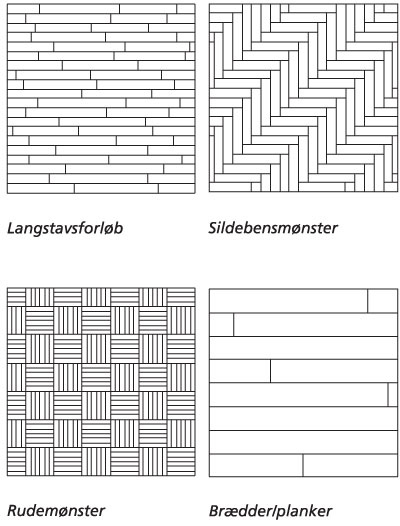
Nye trægulve, der er overfladebehandlet fra fabrik, skal behandles efter trægulvleverandørens anvisninger. Nye ubehandlede trægulve skal slibes, så kvalitetskravene overholdes. Afslibning af trapper foregår efter samme retningslinier som for gulve, dog benyttes der andre maskiner jf. afsnittet om maskiner.
Modtagekontrol
Inden afslibning skal der foretages bestemmelse af henholdsvis tykkelsen af gulvets resterende slidlag på lamelgulve og tykkelsen af notens overlæbe på massive gulve. På lamelgulve gøres det mest sikkert ved at udtage en boreprøve. Lamelgulve med et slidlag på 2 mm og derunder kan ikke afslibes. Resttykkelsen på massive gulve kan som regel måles med et tyndt metalblad i fer- og notsamlingen.
Trægulve nedlagt som langstave
Trægulve nedlagt som langstave kan være udført af:
• Lamelbrædder
• Parketbrædder
• Stavparket
• Gulvbrædder
Fremgangsmåden ved forberedelse er følgende:
• Der udføres modtagekontrol af gulvet.
• Gulvets stabilitet og slidlagets tykkelse undersøges.
• Søm og skruer dykkes.
• Det kan som ekstraarbejde aftales, at knasthuller og lignende større end 10 mm i diameter og mere end 5 mm dybe samt søm- og skruehuller udkittes med egnet materiale i samme træart.
Gulvets tilstand afgør hvilken form for slibning, der skal udføres, herunder hvilket startpapir og eventuelle mellempapirer, der skal anvendes. Hele gulvfladen finpudses på langs af brædderne/stavene.
Efter endt afslibning skal såvel gulvfladen som tilstødende vandrette flader (fodpaneler, vindueskarme o.l.) støvsuges.
Trægulve nedlagt i mønstre (sildeben, rudeparket, mosaikparket o.l.)
Fremgangsmåden ved forberedelse er følgende:
• Der udføres modtagekontrol af gulvet.
• Gulvets stabilitet og slidlagets tykkelse undersøges.
• Søm og skruer dykkes.
• Det kan som ekstraarbejde aftales, at knasthuller og lignende større end 10 mm i diameter og mere end 5 mm dybe samt søm- og skruehuller udkittes med egnet materiale i samme træart.
• Gulvets tilstand afgør hvilken form for slibning, der skal udføres, herunder hvilket startpapir og eventuelle mellempapirer der skal anvendes.
Trægulve nedlagt i mønstre slibes normalt først diagonalt og derefter i rummets længderetning. Alternativt kan gulvet slibes i den retning, hvorfra lyset kommer. Hele gulvfladen finpudses i den retning, hvorfra lyset kommer. Efter endt afslibning skal såvel gulvfladen som tilstødende vandrette flader (fodpaneler, vindueskarme o.l.) støvsuges.
Korkgulve
Det undersøges, om korkgulvet kan slibes. Det anbefales at lave en slibe- og behandlingsprøve forud for arbejdets opstart til fastlæggelse af kvaliteten. En sådan slibe- og behandlingsprøve afregnes særskilt. Herunder bestemmes også korkens tykkelse. Vær opmærksom på, at korkfliser kan være med vinyloverflade. I så fald kan gulvet ikke slibes og heller ikke behandles efter retningslinierne i dette afsnit. Korkgulvet slutslibes med net eller papir og efterbehandles med elastisk overfladebehandlingsmiddel som hærdnende olie eller elastisk lak. Lakbehandling gentages mindst 3 gange. Olie påføres, til gulvet er mættet.
5.3.0.4 Udfaldskrav for afslibning
Efter endt afslibning skal gulvet overholde følgende:
• Gulvfladen skal være plan og jævn, og der må ikke kunne mærkes spring imellem de enkelte brædder/ stave/korkfliser. Overfladen skal være uden synlig vaskebræteffekt.
• Gulvfladen skal være afslebet til rent træ/ren kork.
• Der må ikke være "slibestop" eller "overgange" mellem slibning af fladen og slibning langs kanter og i hjørner.
• Gulvet skal, vurderet i almindelig ståhøjde (1,6 m over gulvet), fremstå glatslebet, og der må ikke forekomme synlige ridser.
5.3.0.5 Overfladebehandling
Formålet med overfladebehandling
Formålet med overfladebehandling af trægulve er at beskytte træet mod slitage, at forhindre/begrænse at smuds eller væskespild trænger ned i træet og at give trægulvet det ønskede udseende. Trægulve leveres ubehandlede eller overfladebehandlede fra producenten, især afhængigt af typen. Parketbrædder og lamelbrædder leveres normalt med overfladebehandling, idet det ikke er nødvendigt at foretage efterbehandling af overfladen, efter at gulvet er lagt. Parketgulve lagt af enkeltstave, mosaikparket og klodsegulve kræver derimod en afslibning efter lægningen, og overfladebehandles derfor først, efter at gulvet er lagt. Laminatgulve kan ikke overfladebehandles. Når laminaten er gennemslidt, må gulvet skiftes.
Som overfladebehandling kan benyttes:
• Ludbehandling
• Sæbebehandling
• Oliering
• Voksbehandling
• Lakering
Overfladebehandlingen af trægulve skal fra tid til anden gentages for at fjerne tilsmudsning, for at forny beskyttelsen og for at bevare det ønskede udseende. Ved valg af overfladebehandling bør der først og fremmest tages hensyn til træarten og det ønskede udseende. Alle typer overfladebehandling kan benyttes under flere forskellige brugsforhold, men den nødvendige vedligeholdsindsats vil variere afhængigt af type af overfladebehandling, brugsintensitet og brugsart. Vær også opmærksom på at for nogle typer af trægulve, ændres gulvet udseende markant ved overfladebehandling. Dette gælder fx. for trægulve med børstet overflade. Ved en traditionel afslibning vil den børstede overflade forsvinde og efterlade en plan og glat overflade. For denne type af gulve er vedligeholdelse af lakken således særlig vigtig. Det er, for alle typer af gulve, vigtigt fra starten at gøre sig klart med hvilke intervaller, der kræves pleje og vedligehold, for at sikre et tilfredsstillende udseende. Især kan der være en konflikt mellem udseende og økonomi, hvis et gulv, der kræver meget vedligehold for at bibeholde det ønskede udseende, anvendes hvor der er stor brugsintensitet. Rengøring og vedligehold af trægulve er nærmere sektionen Rengøring.
Gran og fyr egner sig til såvel lak-, lud-, voks-, sæbe- som oliebehandling. Olie og olie med voks vælges ofte til behandling af de mørke træarter pga. den smukke glød, træet får. Desuden har olie den fordel, at stærkt trafikerede områder kan udbedres partielt i modsætning til fx lak, der som regel kræves en genlakering af hele gulvet. Vedligehold af olie- og voksbehandlede trægulve stiller krav til viden hos den, der forestår den daglige rengøring og vedligehold af gulvet. Det anbefales derfor, at der gives instruktion i vedligehold, før den igangsættes. Der skal altid afleveres en produktbeskrivelse samt en rengørings- og vedligeholdsvejledning for de overfladebehandlingsprodukter, der anvendes. Sikkerhedsdatablade for de overfladebehandlingsprodukter, der anvendes til vedligehold af gulvet, kan rekvireres hos leverandøren. Ved valg af produkt og metode bør både trægulvleverandøren og leverandøren af overfladebehandling tages med på råd, så den optimale behandling i forhold til træart, brugsintensitet mv. sikres. Ved alle former for overfladebehandling kan der forekomme mindre støvpartikler i overfladen, som vil forsvinde ved den løbende rengøring og brug af gulvet. Overfladebehandling af trapper foregår efter samme princip som for gulve. Det skal dog bemærkes, at sliddet på trapper normalt er større end på gulve.
Beskyttelse af trægulve
For at reducere tilsmudsning og beskadigelse bør der anvendes indgangspartier med smudsforebyggende foranstaltninger, fx en kombination af skraberist og måttearrangement, der sikre, at snavs og fugt fjernes fra fodtøjet, inden der gås på gulvet.
Ludbehandling
Ludbehandling er ikke en overfladebehandling, men en forberedelse til en overfladebehandling, fx med sæbe, voks eller olie. Ludbehandling forsinker træets naturlige gulning.
Der findes 2 slags færdiglavet lud:
• Nåletræslud, som anvendes på fyr, gran og pitchpine.
• Hårdttræslud/bøgetræslud, som anvendes på lyse massive hårdttræsgulve.
• Mørke træsorter bør ikke ludbehandles.
Det kan være risikabelt at ludbehandle lamelparketgulve med løvtræsslidlag, da slidlaget kan løsne sig fra det bærende lag (delaminere). Trægulvleverandøren bør derfor tages med på råd inden valg af produkt.
• Inden ludbehandling skal gulvet slibes til rent træ. Gulvet skal være rent og frit for fedt, sæbe, voks eller eventuelle lakrester.
• Gulvet skal være tørt, inden ludbehandlingen påbegyndes.
• Luden påføres gulvet i et jævnt lag med rulle, svaber, pensel eller lignende. Fremgangsmåden skal følge leverandørens anvisning.
• Herefter skal gulvet tørre. Tørretiden afhænger af produktet.
• Når gulvet er tørt slibes det med rondelsliber med polerpads i grøn eller blå farve. Gulvet støvsuges, før den ønskede overfladebehandling påføres.
Til overfladebehandling kan benyttes:
• Sæbe
• Voks
• Olie
Sæbe-, olie- og voksbehandling er nærmere omtalt i de følgende afsnit.
Sæbebehandling
Sæbe fås som natursæbe og som hvid ludsæbe.
Ludsæbe må ikke anvendes på lakerede gulve.
Natursæbe kan anvendes på alle træarter. Hvid ludsæbe må kun anvendes på de lyse træarter. Ved anvendelse af hvid ludsæbe må det ikke forventes, at den karakteristiske hvid-grå farve opnås ved den første påføring.
• Sæben blandes efter leverandørens anvisning og påføres gulvet i et jævnt lag med gulvklud, moppe eller maskine. Herefter tørres gulvet med en hårdt opvredet gulvklud.
For at opnå den bedste beskyttelse bør der mindst foretages 2 sæbehandlinger, inden gulvet tages i brug. På hårde træarter skal der anvendes et minimum af vand ved sæbebehandling.
Udfaldskrav: Mættet ensartet overflade uden overlapninger, med hvid-grå silkemat glans. Overfladen må ikke være ru.
Oliebehandling
Der findes upigmenteret og hvidpigmenteret trægulvolie. Endvidere fås olie med voks. Der skelnes mellem hærdnende og ikke-hærdnende olie, som hver for sig har forskellige egenskaber og krav til vedligeholdsintensitet. Desuden fås UV-færdigolierede trægulve, dvs. gulve, der fra fabrik leveres med en færdig oliebehandling, som ikke kræver yderligere behandling, men kan tages i brug umiddelbart efter lægning. I princippet kan alle træarter oliebehandles. Leverandøren bør dog altid tages med på råd ved valg af produkt. Ved brug af olie skal fremgangsmåden følge leverandørens anvisning, da der kan være stor forskel på arbejdsmetoderne.
En typisk fremgangsmåde er dog følgende:
• Først slibes gulvet til rent træ.
• Derefter netslibes gulvet med net 120 og støvsuges grundigt.
• Olien påføres straks efter i et tyndt jævnt lag med svaber med uldstof, gummiskraber (syrefast) eller rulle i træets længderetning.
• Forbrug og påføring er afhængig af træart og gulvets tilstand, jf. leverandørens anvisning.
Hærdnende olie
• Der påføres olie, indtil træet er mættet i overfladen. Overskydende olie fjernes med bomuldsklude på polermaskine eller manuelt inden for den af leverandøren angivne tid (ca. 20-30 min.), idet der ellers vil kunne komme blanke skjolder fra indtørret olie.
• Efter oliering poleres gulvet med rondelsliber med polerpads og olie efter leverandørens anvisning.
• Til sidst aftørres gulvet med en fnugfri bomuldsklud til overfladen fremstår med silkemat glans.
• Efter angiven tørretid kan gulvet tages i brug. Tørretiden vil fremgå af leverandørens anvisning.
Udfaldskrav: Da oliering er en imprægnering, bør gulvet fremstå med ensartet mættet overflade, uden overlapninger og med ensartet glans. Der må ikke findes overfladefilm af indtørret olie. Olien skal være i træet og ikke på træet. Ved oliering af nylagte gulve og gulve der er afslebet til trærent vil det som regel være nødvendigt at gentage ovenstående processer flere gange for at opnå en mættet og ensartet overflade. Den første oliering anbefales udført med en grundolie, de efterfølgende med en plejeolie. Der bør i hver proces påføres netop den mængde olie gulvet kan optage/suge og overskydende olie bør fjernes.
Antallet af olieringer bør indgå som en det af aftalegrundlaget. Er intet andet aftalt, indeholder en oliering af et nylagt gulv, eller et gulv afslebet til trærent, en grund-oliering og en plejeoliering.
Ikke-hærdnende olie
• Der påføres olie, indtil træet er mættet i overfladen. Efter ca. 1 time fordeles olien igen og sugende områder tilføres mere olie.
• Efter ca. 24 timer poleres gulvet med gule eller hvide polerpads på rondelsliber og efterpoleres med tørre gulvklude.
• Til sidst poleres med crepepapir på polermaskine, evt. med varme.
Efter angiven tørretid kan gulvet tages i brug. Tørretiden fremgår af leverandørens anvisning. Ikke-hærdnende olie bør ikke anvendes på trægulve uden fer og not, som ligger på asfaltunderlag, da dette kan give misfarvning i træet. Endvidere frarådes anvendelse af ikke-hærdnende olie på lamelparket med mindre trægulvleverandøren har sagt god herfor.
Udfaldskrav: Da oliering er en imprægnering, bør gulvet fremstå med ensartet mættet overflade, uden overlapninger og med ensartet glans.
UV-hærdnende olie
• UV-hærdnende olie anvendes udelukkende ved fabriksoliering. Olieringen udføres ved, at olien valses på træet i en maskinel proces, hvorefter olielaget bestråles med UV-lys. På grund af oliens særlige sammensætning sker hærdningen med UV-lys i løbet af få sekunder.
• UV-olierede trægulve kræver normalt ingen efterbehandling. Gulvet kan tages i brug umiddelbart efter lægning, men efter ibrugtagning skal gulvet løbende vedligeholdes efter trægulvsleverandørens anvisninger. Ved polering af gulvoverflader bør kun benyttes bløde bomuldsklude. Brug af slibenet og grove polérpads frarådes.
Hvis gulvet beskadiges under lægning, bør udbedring kun foretages efter trægulvleverandørens anvisninger. Intervallet for vedligehold med plejeolie er afhængigt af gulvets brugssted og trafikintensitet. Det er imidlertid vigtigt, at olien ikke gennemslides, fordi det er vanskeligt at opnå en tilfredsstillende ensartet overflade ved reparation af gennemslidte områder. Stærkt belastede områder i boliger, fx køkkener, gangarealer og lign. kræver måske plejeolie flere gange på et år, mens der kan gå år før mindre trafikerede områder, som fx sove- og opholdsrum kræver oliepleje. I offentlige miljøer, fx cafeer, butikker og lign. steder, hvor der gås med udendørs fodtøj, kan det være nødvendigt at påføre gulvet plejeolie flere gange om ugen. Det anbefales derfor, at der udarbejdes specifikke plejeanvisninger til disse områder. Reparation af beskadigede gulvoverflader kan være vanskelig og bør kun foretages efter trægulvsleverandørens anvisninger. Ved stærkt beskadigede overflader kan det være nødvendigt at slibe gulvet til rent træ og derefter foretage en traditionel oliebehandling.
Voksbehandling
Voks til overfladebehandling findes til såvel ubehandlede som ludbehandlede trægulve. Til trægulve fås både upigmenteret og hvidpigmenteret voks. Hvide gulvoverflader er sarte og kræver derfor hyppig vedligeholdelse. Voksleverandøren bør derfor tages med på råd, hvis denne type overfladebehandling ønskes.
Nyslebne gulve
• Gulvet skal være slebet til rent træ og være fri for voks, fedt, lak og lign.
• Gulvet støvsuges grundigt for rester af slibestøv og andre urenheder.
• Voksen påføres med filtrulle i et jævnt lag. Langs kanter og andre svært tilgængelige steder benyttes pensel. Fremgangsmåden skal følge leverandørens anvisning.
• Efter 6-8 timer poleres gulvet med polermaskine eller manuelt.
Efter angiven tørretid kan gulvet tages i brug. Tørretiden fremgår af leverandørens anvisning.
Ludbehandlede gulve
Gulvet afrenses grundigt for sæbefilm og støvsuges, til overfladen er helt fri for støv og smuds.
• Voksen påføres, som beskrevet under nyslebne gulve.
Udfaldskrav: Mættet ensartet overflade uden overlapninger og med silkemat glans. Overfladen må ikke være ru.
Lakering
• Lakering er en overfladebehandling, som danner en film af nogle få hundrededele mm tykkelse på træets overflade. Lakken kan bidrage til at fremhæve/bevare træets naturlige farver.
• Lakerede gulve kan som regel anvendes i en lang periode, inden det er nødvendigt at genbehandle. I boliger vil levetiden ofte være flere år.
• Lak er resistent overfor de mest almindelige husholdningskemikalier og fås i forskellige kvaliteter til brug i såvel boliger, som lokaler med større belastning.
På markedet findes der forskellige typer, 1- og 2- komponente, vandbaserede og opløsningsmiddelbaserede lakker. Lakkerne består oftest af et system, hvor der først påføres grundlak og efterfølgende afsluttes med toplak.
Nye ubehandlede trægulve og trægulve, der er slebet til rent træ, bør grundlakeres for at mindske risikoen for sidebinding/sidelimning. Det anbefales at kontakte lakleverandøren, der kan anvise produkter til grundlakering, som imødegår sidebinding. Det frarådes at benytte vandbaseret lak på trægulve af Ahorn, der er slebet til rent træ. Ahorn kan indeholde sukkerkrystaller, som ved vandpåvirkning kan give rødbrune pletter i træets overflade.
Ved valg af lak er det vigtigt at vurdere, hvor stort slid der forventes det pågældende sted. Der findes specielle lakker til områder, som udsættes for stor slitage. Tidligere var det nødvendigt at anvende isocyanatlakker, men i dag fremstilles der vandbaserede lakker med tilsvarende slidstyrker.
De fleste lakker kan bruges såvel til nye gulve som til genlakering. Dog kan syrehærdende lak ikke benyttes til genlakering på vandbaseret lak. Lakleverandøren bør altid tages med på råd .
Nyslebne gulve
• Gulvet skal være slebet til rent træ og være fri for voks, fedt, lak og lign.
• Gulvet støvsuges grundigt for rester af slibestøv og andre urenheder.
• Grundlak påføres gulvet i et jævnt lag med rulle eller pensel. Fremgangsmåden skal følge leverandørens anvisning.
• Efter grundlakering eller første gang toplak (afhængigt af leverandørens anvisning) mellemslibes med fint slibepapir eller slibenet. Herefter støvsuges gulvet grundigt.
• Til sidst påføres toplak.
Forbrug og tørretid efter lakleverandørens anvisning.
Udfaldskrav: Mættet ensartet overflade uden overlapninger og med ensartet glans.
Lakerede gulve - genlakering
• Gulvet støvsuges grundigt og afvaskes for sæberester, smuds etc.
• Herefter mellemslibes gulvfladen med fint slibepapir eller slibenet.
• Ved genlakering af nye fabrikslakerede brædder skal der altid foretages en ekstra grundig mellemslibning (mattering af lakoverfladen). Det skal endvidere sikres, at den lak, der anvendes, er forenelig med fabrikslakken.
• Gulvet støvsuges grundigt og aftørres med en fugtig hårdtopvredet klud.
• Toplak påføres gulvet i et jævnt lag med rulle eller pensel. Fremgangsmåden skal følge leverandørens anvisning.
Der påføres et eller to lag toplak med tørretid og mellemslibning imellem hver lakering.
Forbrug og tørretid efter lakleverandørens anvisning.
Udfaldskrav: Mættet ensartet overflade uden overlapninger og med ensartet glans.

